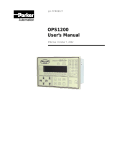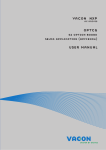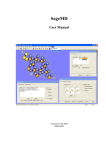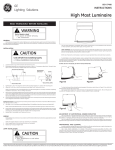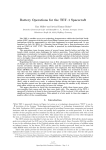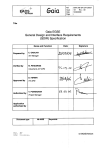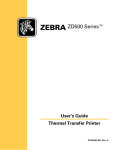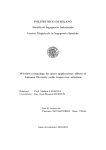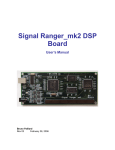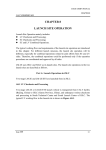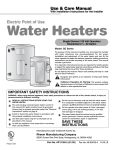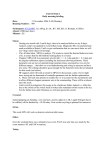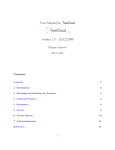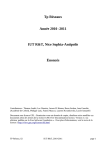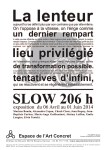Download Mars Express Bus: Simplified User Manual
Transcript
Ref Issue Date Page : : : : MEX.MMT.TN.1297 Draft Rev. : 01 09/04/01 i Title Mars Express Bus: Simplified User Manual Name and Function Prepared by MARS EXPRESS team Date Signature 04/01 Verified by Approved by Authorized by Application authorized by Document type NbCars NbWords 31357 6304 Nb WBS Keywords Astrium Ref Issue Date Page : : : : MEX.MMT.TN.1297 Draft Rev. : 01 09/04/01 ii SUMMARY This Mars Express User Manual for payloads has been issued to provide a quick evaluation frame to assess the suitability of the bus for a given payload, as well as to provide a sound basis for the interface definition of a payload designed to fly on this bus. Mars Express bus was initially designed for a unique mission to Mars, and thus was customised in this objective. The high number and variety of science payloads selected on this first European mission to Mars together with design and development approaches implemented on the program has finally led to produce a bus provided with a high degree of modularity and flexibility, making it potentially suitable for other missions. Its low cost, its short development schedule and its technical characteristics make it attractive for science missions involving orbits far from Earth. The Mars Express User Manual for Payload is composed of a survey of the Mars Express bus highlighting the resources and the interfaces characteristics offered to payloads, It can be complemented if further details are required by the detailed description of the Mars Express payload interface encompassing technical, verification and programmatic interface areas, which is to be found in the Mars Express PID-A, ref. MEX.MMT.SP.0007. Document controlled by NbCars NbWords 31357 6304 Astrium Ref Issue Date Page : : : : MEX.MMT.TN.1297 Draft Rev. : 01 09/04/01 iii DOCUMENT CHANGE LOG Issue/ Revision Draft/00 04/01 First draft issue Draft/01 09/01 “Mex” changed to “Mars Express” on all relevant pages. (ESA action) NbCars NbWords 31357 6304 Date Modification Nb Modified pages Observations Astrium Ref Issue Date Page : : : : MEX.MMT.TN.1297 Draft Rev. : 01 09/04/01 iv PAGE ISSUE RECORD Issue of this document comprises the following pages at the issue shown Page Issue/ Rev. All NbCars NbWords Page Issue/ Rev. Page Issue/ Rev. Page Issue/ Rev. Page Issue/ Rev. Page Issue/ Rev. Draft/0 31357 6304 Astrium Ref Issue Date Page : : : : MEX.MM.TN.1297 Draft Rev. : 01 09/04/01 v TABLE OF CONTENTS 1 INTRODUCTION .......................................................................................................................................... 1 2 MARS EXPRESS BUS OVERVIEW ............................................................................................................... 2 3 SPACE ENVIRONMENT .............................................................................................................................. 6 3.1 RADIATION:......................................................................................................................................................................................6 3.2 THERMAL ENVIRONMENT .............................................................................................................................................................6 4 MECHANICAL INTERFACE ....................................................................................................................... 7 4.1 GEOMETRY ......................................................................................................................................................................................7 Payload interface area available on top floor (top floor sizes 1700 mm x 1500 mm)....................................................................................8 Payload interface area available inside the spacecraft......................................................................................................................................9 4.2 MASS & INERTIA .......................................................................................................................................................................... 10 4.2.1 Mass ...................................................................................................................................................................................... 10 4.2.2 Inertia .................................................................................................................................................................................... 10 4.3 MECHANICAL ENVIRONMENT ................................................................................................................................................... 11 4.3.1 Sine and random environment for internal or external payloads ............................................................................................. 11 4.3.2 Acoustic environment.............................................................................................................................................................. 11 4.3.3 Shock environment ................................................................................................................................................................. 11 5 THERMAL INTERFACE .............................................................................................................................12 5.1 BUS THERMAL CONTROL PRINCIPLES ....................................................................................................................................... 12 5.2 SPACECRAFT THERMAL CHARACTERISTICS .............................................................................................................................. 12 5.3 PAYLOAD THERMAL ENVIRONMENT........................................................................................................................................ 12 6 POINTING AND DYNAMICS .....................................................................................................................14 6.1 POINTING AND STABILITY PERFORMANCE .............................................................................................................................. 14 6.2 ORBIT MANOEUVRING CAPABILITIES ....................................................................................................................................... 14 6.3 DYNAMIC DISTURBANCES ........................................................................................................................................................... 14 6.3.1 Disturbances induced by the bus............................................................................................................................................. 14 6.3.2 Disturbances induced on the spacecraft ................................................................................................................................... 14 7 ELECTRICAL INTERFACE ........................................................................................................................15 7.1 ENERGY AND POWER RESOURCES ............................................................................................................................................. 15 7.2 BUS CONSUMPTION ...................................................................................................................................................................... 16 7.3 POWER LINES ................................................................................................................................................................................ 16 7.4 PYRO LINES ................................................................................................................................................................................... 17 7.5 SIGNAL LINES ................................................................................................................................................................................ 17 NbCars NbWords FileName 31357 6304 Mars Express Bus_ Simplified User Manual draft 01.DOC Astrium Ref Issue Date Page 8 : : : : MEX.MM.TN.1297 Draft Rev. : 01 09/04/01 vi OPERATION INTERFACES........................................................................................................................18 8.1 DATA STORAGE .......................................................................................................................................................................... 18 8.2 TM/TC SERVICES........................................................................................................................................................................ 18 8.3 DMS SERVICES FOR PAYLAODS ................................................................................................................................................. 19 8.4 PAYLOADS COMMANDS DISTRIBUTION .................................................................................................................. 21 8.4.1 TC packet verification by the payloads ................................................................................................................................... 21 8.4.2 Payload switch ON/OFF..................................................................................................................................................... 22 8.4.3 Ancillary data for payloads .................................................................................................................................................... 22 8.5 PAYLOADS TELEMETRY ACQUISITION ...................................................................................................................................... 22 8.5.1 Standard telemetry and low rate science data .......................................................................................................................... 22 8.5.2 High rate science data ............................................................................................................................................................ 22 8.5.3 Monitoring approach.............................................................................................................................................................. 22 8.5.4 Monitoring using Service 3..................................................................................................................................................... 23 8.6 9 PAYLOADS POLLING ALGORITHM ............................................................................................................................................. 24 MARS EXPRESS BUS ADAPTATIONS ...................................................................................................... 26 9.1 EASY ADAPTATIONS..................................................................................................................................................................... 26 9.1.1 Payload accommodation.......................................................................................................................................................... 26 9.1.2 Payload radiators ................................................................................................................................................................... 26 9.1.3 9.2 Payload Power lines................................................................................................................................................................ 26 MORE COMPLEX ADAPTATIONS ................................................................................................................................................ 26 9.2.1 Star tracker accommodation ................................................................................................................................................... 26 9.2.2 High gain antenna ................................................................................................................................................................. 27 NbCars NbWords FileName 31357 6304 Mars Express Bus_ Simplified User Manual draft 01.DOC Astrium Ref Issue Date Page 1 : MEX.MMT.TN.1297 : Draft Rev: 00 : 04/04/01 : 1 INTRODUCTION This Mars Express User Manual for payloads has been issued to provide a quick evaluation frame to assess the suitability of the bus for a given payload, as well as to provide a sound basis for the interface definition of a payload designed to fly on this bus. Mars Express bus was initially designed for a unique mission to Mars, and thus was customised in this objective. The high number and variety of science payloads selected on this first European mission to Mars together with design and development approaches implemented on the program has finally led to produce a bus provided with a high degree of modularity and flexibility, making it potentially suitable for other missions. Its low cost, its short development schedule and its technical characteristics make it attractive for science missions involving orbits far from Earth. The Mars Express User Manual for Payload is composed of a survey of the Mars Express bus highlighting the resources and the interfaces characteristics offered to payloads, It can be complemented if further details are required by the detailed description of the Mars Express payload interface encompassing technical, verification and programmatic interface areas, which is to be found in the Mars Express PID-A, ref. MEX.MMT.SP.0007. (Mars Express Bus_ Simplified User Manual draft 01.DOC) Ref Issue Date Page 2 : MEX.MMT.TN.1297 : Draft Rev: 00 : 04/04/01 : 2 MARS EXPRESS BUS OVERVIEW Mars Express bus is designed to support interplanetary missions using the Soyuz Fregat launcher. Mars Express launch mass can reach up to 1200 kg, within which the bus dry mass account for 500 kg. Propulsion tanks can accommodate up to 500 kg of biliquid propellant (MMH/NTO). The spacecraft design is based on a parallelepipedic like shape sizing about 1.7 m length, 1.7 m width and 1.5 m height. The original articulation concept includes body mounted instruments, a fixed high gain antenna and a one degree of freedom steerable solar array. This solar array is composed of two deployable wings providing a symmetrical spacecraft configuration. The spacecraft structure is made of aluminium honeycomb. The thermal control is based on a passive design with MLI and radiators complemented by heaters. Four main assemblies have to be distinguished within the integrated design of the bus to streamline the development and integration process: (1) the propulsion module with the core structure composed of a launch interface ring, a lower floor “-Z”and three shear walls, (2) the lateral walls “Y” supporting the solar arrays and the spacecraft avionics, (3) the “X” side wall supporting the high gain antenna (4) the payload accommodation areas made of the top floor “+Z” and the “+X” cavities. The avionics is inherited from Rosetta. The Attitude and Orbit Control is achieved using a set of star sensors, gyros, accelerometers and reaction wheels. A bi-propellant composite propulsion system is used of orbit and attitude manoeuvres through banks of 10 N thrusters and eventually a 400 N main engine. The data handling is based on packet telemetry and telecommand, the spacecraft being operated from ground through Mission Time Line management. RF communications with ground are done in S or X band. The telecommand rate can be selected between 7.81 and 2000 kbps, while the telemetry rate can be selected between 10.7 bps and 230 kbps (X band). The electrical power generation is performed by solar arrays, and the power storage by lithium ion batteries. The power conditioning system adjusts the power retrieved from the solar array to the power required inside the spacecraft A 28 V regulated power is distributed to the spacecraft users through latch current limiter protected lines. (Mars Express Bus_ Simplified User Manual draft 01.DOC) Ref Issue Date Page 05/10/2000 18:53:05 05/10/2000 18:29:21 (Mars Express Bus_ Simplified User Manual draft 01.DOC) : MEX.MMT.TN.1297 : Draft Rev: 00 : 04/04/01 : 3 Ref Issue Date Page 05/10/2000 18:15:07 07/12/2000 18:08:45 (Mars Express Bus_ Simplified User Manual draft 01.DOC) : MEX.MMT.TN.1297 : Draft Rev: 00 : 04/04/01 : 4 Ref Issue Date Page 07/12/2000 18:09:15 06/12/2000 11:49:45 (Mars Express Bus_ Simplified User Manual draft 01.DOC) : MEX.MMT.TN.1297 : Draft Rev: 00 : 04/04/01 : 5 Ref Issue Date Page 3 : MEX.MMT.TN.1297 : Draft Rev: 00 : 04/04/01 : 6 SPACE ENVIRONMENT Mars Express bus is basically designed for interplanetary missions. The bus is typically able to operate without noticeable modifications between Venus and the asteroid belts. The solar arrays are not large enough to generate electrical power beyond the asteroid belt and the thermal design is not sized to operate close to the Sun. 3.1 RADIATION: The bus unit components have been selected with respect to a cumulated dose of 6 Krads below 22 aluminium shielding. Parts have been considered as directly suitable if they have been evaluated successfully up to 12 Krads (margin factor of 2), or after having been submitted to a Radiation Verification Test RVT with an acceptance critéria of 7.8 Krads (margin factor of 1.3) Bus parts are latch up immune with a Minimum threshold value LET: 3.2 • For Single Event Upset (SEU) LET > 25 Mev.cm².mg-1 • For Single Event Latch ups (SEL) LET > 100 Mev.cm².mg-1 THERMAL ENVIRONMENT The bus has been customised to cope with a wide range of thermal environment, from Near Earth conditions with Sun and Earth contributions (hot case) to Mars conditions where eventually 100 mn eclipses far from Mars (11000 km) are met (cold case) (Mars Express Bus_ Simplified User Manual draft 01.DOC) Ref Issue Date Page 4 : MEX.MMT.TN.1297 : Draft Rev: 00 : 04/04/01 : 7 MECHANICAL INTERFACE 4.1 GEOMETRY Two main areas are devoted to payload accommodation on the bus. Flexibility is provided for accommodation in these two areas, allowing to cope with experiment footprints and insert plans. • The area located inside the bus is rather for payload units of small to medium size. Units compliant with the available volume benefits from the spacecraft structure protection and from the internal ambient environment. The internal volume dedicated to payload is composed of the upper part of the alveolas below the X wall, opposite to the high gain antenna wall. The payloads are nominally mounted directly on the shear wall, which provides a structural path during launch and manoeuvre phase. Dedicated secondary structure can be defined on a case by case basis to account for unit specific mounting constraints (as for the Omega experiment or the PFS experiment on Mars Express ) The spacecraft external X wall is used a closure wall, easily dismountable to provide a possible late access during integration phases. Depending on the selected flight attitude, this closure wall can be equipped with mission customisable radiators for payload. • the other external, on the top floor for external units of larger dimensions or for units requiring large filed of view. Strong attachment points are nominally provided on the upper edge of the shear walls, while additional strong points can be provided with customised struts (as for the Mars Express Beagle 2 lander) Additional accommodation points can be envisaged on a case by case basis for small to medium experiment units (as for the Mars Express Marsis experiment on the +Y wall or for one sensor of the Mars Express Aspera experiment on the –Z floor.). Such particular accommodation is not recommended to avoid interference with bus unit fixations and radiators and to avoid redesign of bus unit dedicated structures. (Mars Express Bus_ Simplified User Manual draft 01.DOC) Ref Issue Date Page 4.1.1 : MEX.MMT.TN.1297 : Draft Rev: 00 : 04/04/01 : 8 Payload interface area available on top floor (top floor sizes 1700 mm x 1500 mm) Strong structural points areas provided on shear wall edges Holes:mission customisable (Mars Express Bus_ Simplified User Manual draft 01.DOC) Ref Issue Date Page 4.1.2 Payload interface area available inside the spacecraft Volume available for payload internally accommodated (Mars Express Bus_ Simplified User Manual draft 01.DOC) : MEX.MMT.TN.1297 : Draft Rev: 00 : 04/04/01 : 9 Ref Issue Date Page 4.2 4.2.1 : : : : MEX.MMT.TN.1297 Draft Rev. : 00 04/04/01 10 MASS & INERTIA Mass The structure is qualified to support a 1200 kg spacecraft launched under a Soyuz Fregat or a Delta 2 environment. In case of Soyuz Fregat, a lightweight conical launch vehicle adapter LVA has been developed in the frame of Mars Express. This 40 kg LVA is bolted on Fregat, and interfaces with the spacecraft through a 937 mm ring and a clampband / spring system. The bus dry mass is equal to 500 kg. Provided that the launcher is able to inject 1200 kg (above the LVA) on the targeted orbit, the available payload mass results in first order from the required propellant mass. The tanks can be launched with a filling ratio between 55% and 100%, i.e. between 330 and 600 kg. This leaves between 100 kg and 370 kg for the science payload. This mass includes payload harness, specific secondary structures and specific thermal hardware. 4.2.2 Inertia Very different inertia configurations are encountered on Mars Express, each of them resulting in specific AOCS control law tuning. No strong limitations are identified with respect to inertia limits, although tuning of spacecraft attitude control laws may have to be performed in case of major evolutions with respect to the values given table here below: Inertia wrt CoG Ixx Izz Izz Inertia cross products Launch, full tanks 400 m²kg 300 m²kg 400 m²kg < 20 m²kg Solar array deployed, full tanks 1000 m²kg 400 m²kg 1000 m²kg < 20 m² kg Solar array deployed, payload deployed, tanks empty 900 m²kg 600 m²kg 1200 m²kg < 30 m²kg (Mars Express Bus_ Simplified User Manual draft 01.DOC) Ref Issue Date Page 4.3 4.3.1 : : : : MEX.MMT.TN.1297 Draft Rev. : 00 04/04/01 11 MECHANICAL ENVIRONMENT Sine and random environment for internal or external payloads The payload (internal or external shall comply with the following environments Sine Frequency All axis Random Frequency Vertical Lateral 4.3.2 0-100 Hz 20-100 Hz 100-400 Hz 400-2000 Hz GRMS 20-100 Hz 100-400 Hz 400-2000 Hz GRMS Qualification (2 oct/min) 20 g Acceptance (4 oct/min) 13.3 g Qualification (120s duration) 6 dB/oct 0.55 g²/Hz -6 dB/oct 19 6 dB/oct 0.1 g²/Hz -3 dB/oct 9.88 Acceptance (60 s duration) 3 dB / oct 0.16 g²/Hz -6 dB/oct 12.7 6 dB/oct 0.045 g²/Hz -3 dB/oct 6.63 Acoustic environment Large external payloads have to be qualified for the following acoustic environment Octave band center frequency (Hz) 31.5 63 125 250 500 1000 2000 Overall 4.3.3 Sound pressure level, dB (Ref 0.0002 N/m²) 125 134 135 138 137 128 124 143 Shock environment The payload shall comply with a Shock Response Spectra (SRS) of 1500 g from 1000 Hz to 10000 Hz (Mars Express Bus_ Simplified User Manual draft 01.DOC) Ref Issue Date Page 5 : : : : MEX.MMT.TN.1297 Draft Rev. : 00 04/04/01 12 THERMAL INTERFACE 5.1 BUS THERMAL CONTROL PRINCIPLES Two types of payload interfaces: internal and collectively controlled, or external: and decoupled. The control of the spacecraft internal thermal environment throughout all mission phases is achieved by means of a combination of passive and active thermal control techniques. The basic idea of the Tthermal Control System is to insulate the spacecraft from the external environment by means of classical Multi Layer Insulation and to maintain an internal electrical dissipation as constant as possible in the various modes and phases of the mission. Radiators are however implemented on the Y panels (normal to the solar arrays thus nominally away from the Sun) to reject the heat generated by high dissipative and/or high power density spacecraft units. The radiator areas are covered whenever required with white paint, Secondary Surface Mirrors or Optical Sun Reflector in order to reduce potential impact from appendages reflected Sun heat flux. All internal units shall be black painted to increase mutual radiative exchanges, hence decreasing gradient. Electrical heaters maintain spacecraft interior and specific units within the required temperature range. Finally, the Thermal Control System is supported by the spacecraft avionic to perform acquisition of the thermal telemetry data, control and surveillance of the electrical heaters. 5.2 SPACECRAFT THERMAL CHARACTERISTICS The spacecraft MLI blanket is black kapton, with: • an IR emittance of 0.45 to 0.75 • a solar absorbance around 0.45 • an effective emittanc of 0.01 to 0.03. 5.3 PAYLOAD THERMAL ENVIRONMENT The thermal interface between payload and bus is defined by the Temperature Reference Point TRP and by the Environment Temperature. • The TRP is defined at the mounting interface between the payload unit and the bus, on the payload side. This is the conductive interface temperature experienced by the units. It is the only temperature controlled and guaranteed by the spacecraft. • The Environmental Temperature is the radiative temperature experienced by the units. This temperature shall be used by the payload supplier to perform its thermal design. (Mars Express Bus_ Simplified User Manual draft 01.DOC) Ref Issue Date Page : : : : MEX.MMT.TN.1297 Draft Rev. : 00 04/04/01 13 For payload accommodated inside the spacecraft, the following ranges of temperature have to be taken into account: Temperature range Operating conditions Non operating conditions TRP temperature -10 to +40°C -20 to + 50°C Environment temperature -10 to + 40°C -20 to +50°C For payload accommodated the spacecraft, the TRP temperature and the Environment Temperature depends of the flight operation scenario. (Mars Express Bus_ Simplified User Manual draft 01.DOC) Ref Issue Date Page 6 : : : : MEX.MMT.TN.1297 Draft Rev. : 00 04/04/01 14 POINTING AND DYNAMICS 6.1 POINTING AND STABILITY PERFORMANCE The bus provides the following typical performances: Attitude knowledge w.r.t a stellar direction Pointing accuracy w.r.t. a stellar direction Rate stability Pointing stability over 10 s Pointing stability over 60 s Max slewing rate 6.2 0.05 deg 0.06 deg 0.003 deg/s 0.005 deg 0.009 deg 0.15 deg/s ORBIT MANOEUVRING CAPABILITIES The bus can accommodate up to 600 kg of propellant, among them about 570 kg can be used for orbit manoeuvres. Orbit manoeuvers can be performed along the spacecraft Z axis, either • with main engine (430 N thrust, 317 s Isp in steady state) complemented with four 10 N thrusters for attitude control in modulation (providing a additional thrust of about 15 N, Isp of 280 s) • with four 10 N thrusters in on modulation (35 N thrust bout Z, Isp 285 s) 6.3 DYNAMIC DISTURBANCES 6.3.1 Disturbances induced by the bus Low frequency disturbances generated by the bus: Observation Attitude manœuvre Very low Very low Wheel off Trajectory loading correction < 1.5 deg/s < 1.5 deg/s Safe mode / attitude reacquisition < 1.5 deg/s Angular acceleration Angular rate Very low < 0.15 deg/s < 0.15 deg/s Up to 5 deg/s < 0.2 deg/s Linear Very low Very low 0.05 m/s2 0.05 m/s2 0.1 m/s2 + dynamic acceleration effects TBC High frequency disturbances generated by the bus: The microvibartions generated by reaction wheels at structure / instrument interface remain below 4 microrad in the frequency range [20 Hz, 150 Hz] 6.3.2 Disturbances induced on the spacecraft The spacecraft performances are guaranteed for payload: • Inducing disturbing torque < 10 mNm (stability performances) • Provided with flexible modes > 0.1 Hz (Mars Express Bus_ Simplified User Manual draft 01.DOC) Ref Issue Date Page 7 : : : : MEX.MMT.TN.1297 Draft Rev. : 00 04/04/01 15 ELECTRICAL INTERFACE 7.1 ENERGY AND POWER RESOURCES The bus is provided with a Globalstar solar array and three 22.5 Ah Li ion batteries. The power is conditioned in a PCU before being distributed to users under 28 V regulated voltage. The PCU is able to deliver up to 1500 W on the power bus. During eclipses, the PCU can draw up to 750 W from the batteries and to deliver them to the users (bus units and payloads) Solar array characteristics • • • • • • • • • • • • • • • • • • Cell type Cell efficiency (BOL, 28°C) Efficiency losses due to temperature Matching factor (Current/Voltage) Calibration factor (Current/Voltage) Coverglass gain Cell/Interconnecion resistance Voltage drop due to diodes Life time degradation due to radiation Life time degradation due to others Thermal absorption coefficient substrate front Thermal absorption coefficient substrate rear Thermal absorption coefficient cell Thermal conductivity cell to substrate Thickness of substrate Panel surface Number of panels per wing Number of wings Si BSR 0.1280 [-] 0.004 [1/°C] 0.99/1 [-] 0.99/1 [-] 0.95 [-] 0.1783 [Ohm] 0.8 [V] Orbit dependant 0.0125 [1/a] 0.872 [-] 0.879 [-] 0.72 [-] 0.48 [W/(mK)] 0.002 [m] 800 x 1778 [mm xmm] 4 [-] 2 (-] Li-ion batteries • • • • • • • • • Number of battery Number of strings per battery Number of cells per string Cell type Cell operating voltage range Internal cell resistance Internal resisatnce increase due to ageing Capacity degradation (ageing and cycling) Chemical diffusion effect (Mars Express Bus_ Simplified User Manual draft 01.DOC) 3 16 in parallel 6 in series Sony US 18650 (1.5 A) 2.5 V to 4.2 V Below 0.5 Ohm above 3 V 35% per year 10% per year Internal resistance increased by a factor 1.75 Ref Issue Date Page : : : : MEX.MMT.TN.1297 Draft Rev. : 00 04/04/01 16 Power Conditionning Unit (PCU) Characteristics • • • • • • • • • 7.2 Power losses Solar array regulator effciciency Battery discharge regulator efficiency Battery charge regulator efficiency BCDR constraints Max battery discharge current (BCDR input o battery side) Max battery discharge current (BCDR output, PCU main bus side Max battery charge current (BCDR output, battery side) Min battery terminal voltage (discharge, BCDR output, battery side) 90% 90% 90% 17 A 9A 9A 16 V BUS CONSUMPTION The following values shall be taken into account for power budget elaboration Fine pointing Bus subsystem Bus thermal control Maneeuvre Comm’s Observation Slew Orbit control 450 W 300 W 400 W 300 W Up to 200 W (flight operation dependant) On top on this values, payload power and payload thermal control power have to be added. 7.3 POWER LINES The power is distributed to payload users through 28V regulated lines, protected by Latch Current Limiters “LCL”. The selection of the LCL has to be done as a function of the required power loads and within the following categories: LCL class definition LCL class Class A Class B Class C Class D Class E Class G Trip off / limiting point 11 W/0.4 A 22 W/0.8 A 44 W/1.6 A 82 W/3.0 A 109 W/4.0 A 163 W/6.0 A Max. nominal current 0.3 A 0.6 A 1.2 A 2.3 A 3.1 A 4.6 A Available lines 2x1 2x1 2x4 2x3 2x1 2x1 The detailed electrical characteristics of each individual line can be found in PID-A annex 1. (Mars Express Bus_ Simplified User Manual draft 01.DOC) Ref Issue Date Page 7.4 : : : : MEX.MMT.TN.1297 Draft Rev. : 00 04/04/01 17 PYRO LINES 2 x 8 Pyro Firing Lines provided with the following characteristics are available for payloads (See detailed specification in PID-A annex 1. Source circuit specification Firing pulse duration 24 ± 2 ms Repetition rate > 100 ms Firing current 4.5 A > Ifire< 6.0 A Receiver circuit specification Max no firing current 1 A for 5 mn All fir current 4.0 A within 20 ms 7.5 SIGNAL LINES The bus interfaces with payloads following TTC-B-01 standards for TT/C functions. The bus provides the following quantities of TTC interface for command control: Type Acrony m Available number of lines High power command HPC 2 x 64 Memory load command MLC 2 x 32 Time synchronisation TSY 2 x 12 Analogue telemetry ANS 2 x 18 Thermistor acquisition ANC 2 x 32 Platinum sensor acquisition ANP 2x8 Serial 16 bit digital telemetry SDT 2 x 32 Relay switch status RSS 2 x 18 High frequency clock HFC 2 x 18 High rate channel IEEE 1553 HRD 2x3 (Mars Express Bus_ Simplified User Manual draft 01.DOC) Ref Issue Date Page 8 8.1 : : : : MEX.MMT.TN.1297 Draft Rev. : 00 04/04/01 18 OPERATION INTERFACES DATA STORAGE The bus provides a data storage capability (Solid State Mass Memory SSMM) of 12 Gbits. The SSMM is provided with file management functions. 8.2 TM/TC SERVICES This chapter describes the bus software functions available for the management of the payloads. q The list of services offered by the bus to the payloads, q The payloads commanding principle, q The payloads telemetry acquisition principle, q The payloads monitoring, q The payloads polling algorithm. Detailed requirements applicable to the payloads are described in the PID-A. Interface between the payloads and the S/C is done via the DMS software by means of packetised TM/TC, both for housekeeping and science data. The structure of the TM/TC packets is described in chapters 5 and 6 of the SGICD. Housekeeping data for all the payloads are acquired on the OBDH bus. Science data are acquired and send to the SSMM either: q On the OBDH bus for low rate payloads. The OBDH available bandwidth for payload telemetry (cumulated traffic to be shared by all payloads using the bus) is 75 kbps mean / up to 100 kbps peak q On the IEEE-1355 bus for high rate payloads (up to 25 Mbps) towards a one-way connection. The SSMM does not transfer any data to the payloads. (Mars Express Bus_ Simplified User Manual draft 01.DOC) Ref Issue Date Page 8.3 : : : : MEX.MMT.TN.1297 Draft Rev. : 00 04/04/01 19 DMS SERVICES FOR PAYLAODS The bus provides the payloads with the following services: q Service 2: Device command distribution, q Service 7: OBCP management, q Service 9: Time synchronisation, q Service 12: On-board monitoring, q Service 13: Large data transfer, q Service 14: Packet real-time downlink control, q Service 15: On-board TM storage and retrieval, q Service 16: On-board traffic management, q Service 17: Connection test, q Service 20: Science data transfer. Service 2: Device command distribution This service is used to distribute discrete commands to any users and includes: q Distribute ON/OFF commands: they are handled by the DMS software, the commands are distributed to the user, no packet protocol is used, only the data segment of the packet is sent to the addressed user. q Distribute register load commands. q Distribute CPDU commands: allows the command decoder to directly issue pulse commands over a dedicated harness. Service 7: OBCP management The spacecraft is able to execute a sequence of pre-defined on-board control procedures (OBCP) initiated either from the ground of from the mission time-line (via time-tagged commands). OBCPs are able to send telecommands, test parameters and branch on the result. They can be seen as an extension of the ground. Each PI has to define the required number of nominal and contingency OBCPs. The OBCP description shall include at least the following information: OBCP ID, OBCP mnemonic, OBCP short description, OBCP long description, OBCP parameters, parameters description, reference to the TM and TC used, listing of the OBCP pseudo-code (in Spacecraft Control Language if possible). Service 9: Time synchronisation The S/C, all equipment and instruments using time information shall have the same on board time reference called “Spacecraft Elapsed Time” (SCET). The reference SCET is generated by the CDMU (Central Data Management Unit) and is distributed by the bus through Service 9 as described in the SGICD. (Mars Express Bus_ Simplified User Manual draft 01.DOC) Ref Issue Date Page : : : : MEX.MMT.TN.1297 Draft Rev. : 00 04/04/01 20 The accuracy of the SCET with respect to the Universal Time (UTC) is 20 msec within 1 hour.. The SCET shall be used as the time reference to time-stamp all payloads TM packets. Payloads shall support TM time-stamping to an accuracy of 100 msec over a TBD time interval. Time synchronisation The synchronisation within the instrument shall be in conformance with the “Timer Synchronisation” procedure described in PID-A, Annex A (E-IDS), chapter 4.4. In this chapter, BCP 3 transmitted on the OBDH bus, is then transmitted to the instrument via the RTU under the name “Timer Synchronisation signal” (TSY). As long as the instrument is not time synchronised with the SCET, it shall flag this by setting the MSB of the Time Field of the Data Field Header of each TM packet to “1” (cf. SGICD chapter A6.3.6). In this case, the meaning of the rest of the Time Field is normally used to indicate the time. Service 12: On-board monitoring Service 12 is used to monitor parameters and events contained in the on-board data pool against a limit set or an expected status value. Service 13: Large data transfer For payloads, this service is used to transfer TCs files to any payload through the SSMM. TC files are sent to the SSMM through a protocol which includes error correction and retransmission of corrupted data by the ground. Once the transmission is completed, all the files are concatenated into a single file in the SSMM and the TCs are either processed immediately by the DMS (TC are sent to the payloads according to the file destination) or kept in the SSMM until the private TC requesting activation of the TC file is sent by the ground to the DMS. Service 14: Packet real-time downlink control This service controls the amount of data that is sent in real-time to ground during a pass. All the packets corresponding to an enabled APID are placed in the real time transfer frame. The frame is down linked when full or the transmission of a time packet is required. Service 14 enables/disables the downlink of selected packets by APID (see Appendix 3 of SGICD for APID definition of each end-user). It requests and reports the APIDs that are enabled for downlink in real time. Service 15: On-board TM storage and retrieval This service controls the storage to and the retrieval of TM packets from the SSMM. This service allows the selection of the packets to be stored in each packet store, together with selecting which stores are down-linked. A packet store is a set of TM packets corresponding to different APIDs. q The definition of packet store is performed through an SSMM private service. (Mars Express Bus_ Simplified User Manual draft 01.DOC) Ref Issue Date Page q : : : : MEX.MMT.TN.1297 Draft Rev. : 00 04/04/01 21 A packet store is modified by adding/deleting the TM packets corresponding to a certain APID. If an APID is deleted, than all the TM packets associated with this APID are suppressed from the store. If an APID is added, all the TM corresponding to this APID are added in the store. Service 16: On-board traffic management Service 16 is not directly applicable to payloads. Nevertheless, it concerns the payloads in the sense that the bus uses this service to: q Define the nominal or Redundant branch for a payload instrument data transfer, q Enable/disable the polling of the instrument, q Enable/disable TC sending to the instrument. Service 17: Connection test This service allows the verification that a unit is still functioning by performing a test on a packet telemetry source. As some users will not produce telemetry packets on a regular basis, Service 17 allows the link between bus and packetised users to be tested. Due to the autonomous nature of operations for interplanetary missions, the service supports a timeout and event packet generation. 8.4 PAYLOADS COMMANDS DISTRIBUTION All commands to the payloads are issued by the DMS software via the OBDH bus and the RTU as telecommand packets. These commands are sent to the payloads via the DMS software through the RTU. They originate either from the ground or the DMS itself. The telecommand packets structure is defined in the SGICD, The TC packets are then decoded by the payloads. The payload shall also conform to the telecommand packets structure defined in the SGICD. Each payload generates a time-out in case a complete TC packet is not received within 2 sec. 8.4.1 TC packet verification by the payloads The following standard verification shall be performed by the payload on reception of each TC packet: Ø check that the process identifier (PID) belongs to the possible PID for the instrument, Ø check that the type/subtype belongs to the list of types/subtypes applicable to the instrument, Ø check that the length mentioned within the packet header is consistent with the normal length (or range of possible lengths) associated to this command defined by type/subtype, Ø check that the received CRC is consistent with the data contained within the TC packet (by computing the CRC on the received data and comparing it with the received CRC), Ø check that the current operation mode is consistent with the authorised operation modes to execute the command. (Mars Express Bus_ Simplified User Manual draft 01.DOC) Ref Issue Date Page : : : : MEX.MMT.TN.1297 Draft Rev. : 00 04/04/01 22 Specific verification shall be executed on the specific data contained within the “application data field”, case by case for each type/subtype. When the TC acceptance checks are negative, an acceptance failure report shall be generated if required within the TC. In this case the TC shall not be executed, so no execution report is generated (nor execution failure report) even if the telecommand requires both acceptance and execution report. 8.4.2 Payload switch ON/OFF Payloads switch ON/OFF is initiated under ground command. The TC is received by the DMS which acts as a TC router and sends the TC to the payload user based on the APID. No filter is ensured by the DMS (e.g. the DMS does not check if the TC is compatible with the current payload mode). At payload power switch on, the payload shall autonomously perform: q a self check and inform the DMS in an event packet. q a full boot-up to a Stand-By mode or an operational mode. 8.4.3 Ancillary data for payloads The selected approach for the delivery to the payload of S/C related parameters is that such parameters are sent to the payloads by the ground on a regular basis. This means that the payloads shall define their own set of private TCs. These TCs are routed to the payloads by the DMS software. The delivery of a S/C parameter to a payload is ensured by the ground through the DMS software. 8.5 8.5.1 PAYLOADS TELEMETRY ACQUISITION Standard telemetry and low rate science data Standard telemetry and low rate science data are acquired from the payloads by the DMS computer onboard the spacecraft via the OBDH bus and the RTU as TM source packets. The payloads provide its telemetry data to the spacecraft RTU in source packet data. The structure of the TM packet shall conform to the SGICD. 8.5.2 High rate science data High telemetry rate payloads shall have a direct connection to the SSMM through IEEE-1355 bus. Science packets are not processed by the DMS software, they are just stored on board before transmission to ground in a SSMM provided with file management functions. . 8.5.3 Monitoring approach Low level monitoring and actions are performed by the payload and signalled to the ground through the DMS by event and housekeeping packets. (Mars Express Bus_ Simplified User Manual draft 01.DOC) Ref Issue Date Page : : : : MEX.MMT.TN.1297 Draft Rev. : 00 04/04/01 23 High level monitoring and recovery actions are performed by the ground through the DMS using predefined procedures and operating on event and housekeeping packets. The payload shall perform self monitoring at regular intervals. If an error is detected, then the payload shall enter its Safe Mode autonomously, inform the DMS in an event packet and await DMS to perform a predefined procedure to recover experiment. 8.5.4 Monitoring using Service 3 The unique TM packet received from the Payload and processed by the DMS software is the TM “Housekeeping Report Packet”. All other TM packets are routed either to the SSMM or directly to the ground. (Mars Express Bus_ Simplified User Manual draft 01.DOC) Ref Issue Date Page 8.6 : : : : MEX.MMT.TN.1297 Draft Rev. : 00 04/04/01 24 PAYLOADS POLLING ALGORITHM The main characteristics of the algorithm are the following: Ø Each payload is polled at least once within a 8 sec period. Ø Each payload is not polled more than once within a 1 Hz cycle. Ø The algorithm is independent on the number of payloads to be polled, and therefore is valid for all phases of the mission. Polling and data acquisition of a given payload is nevertheless asynchronous, as detailed below. The polling sequence is executed after the “Non packet TC distribution and TM acquisition” (which lasts 125 msec on the 1 Hz cycle), and after the “TC packet distribution”. As a 1 Hz cycle starts with a fixed duration allocated to non-packet users (125 ms). There is a minimum time interval of 125 msec between the end of acquisition on a payload and the start of a new polling for the same payload. The N payload experiments shall be polled sequentially, always in the same order (PL 1 to PL N), according to the enable/disable status defined by Service 16 (i.e. if PL i is disabled the polling sequence pass directly from PL i-1 to PL i+1). Each payload shall include a buffer to store its own data, as the polling frequency of one payload can be smaller than the payload data acquisition frequency. If the polling of all payloads takes more than the available time on one 1 Hz cycle, the remaining data to be acquired (for the current complete polling sequence from PL 1 to PL N) shall be acquired on the next 1 Hz cycles (Mars Express Bus_ Simplified User Manual draft 01.DOC) Ref Issue Date Page : : : : MEX.MMT.TN.1297 Draft Rev. : 00 04/04/01 25 <------------------------------------------------------------ 1 Hz cycle -----------------------------------------------------------> TC dist. & TM TC packet dist. acq for Non for Packet users Packet TM block acquisition packet user. Fixed Variable Variable 12,5 % = 125 25 % max. = 62,5 % min. = msec 250 msec max. 625 msec Min. Execution of the polling sequence in a 1 Hz cycle <------------------------------------------------------------ 1 Hz cycle -----------------------------------------------------------> TC dist. & TM acq TC packet dist. PL PL for Non packet for Packet users 1 2 ... ... ... PL PL ... ... i-1 i+1 ... PL PL Not N-1 N used user. If supposed PL i is disabled Sequential polling of all payloads cycle PL PL i-1 1 2 cycle i PL PL 1 2 ... cycle PL PL i+1 1 2 ... ... ... ... ... ... PL PL i-1 i+1 PL PL I-1 i+1 ... ... ... PL PL i-1 i+1 ... ... ... ... ... .. ... ... PL PL 11 12 PL PL 11 12 PL PL 11 12 Not used Not used Not used Case where polling is completed within a cycle cycle PL PL i-1 1 2 cycle i ... ... PL9 PL PL i-1 i+1 ... (remaining part) cycle PL PL i+1 1 2 ... ... ... ... ... PL PL 11 12 PL PL i-1 i+1 ... Figure : Case where polling is not completed within a cycle (Mars Express Bus_ Simplified User Manual draft 01.DOC) PL PL9 8 (first part) Not used .. ... PL PL 11 12 Not used Ref Issue Date Page 9 : : : : MEX.MMT.TN.1297 Draft Rev. : 00 04/04/01 26 MARS EXPRESS BUS ADAPTATIONS Some flexibilities and tuning can be introduced in the in the Mars Express bus definition, without impacting noticeably the development of a recurrent bus 9.1 EASY ADAPTATIONS Easy adaptations are to be understood as bus adaptation that can be envisaged to better accommodate the payload without affecting the “recurring” characteristic of the bus. Those modiications have however to be notified early in the design phase, to be included without impacting the development schedule. 9.1.1 Payload accommodation Additional accommodation areas can be envisaged on a case by case basis, as performed on Mars Express for the MARSIS radar antenna or the ASPERA sensor. Specific secondary structures can also be implemented, as performed on Mars Express for the Beagle 2 lander, the PFS spectrometer or the OMEGA spectrometer. 9.1.2 Payload radiators The –X wall is a closure wall, nominally kept away from Sun can be customised with respect to payload radiator accommodation. 9.1.3 Payload Power lines I the early design definition phase of the mission, LCL classes can be modified as follows: • LCL class A can be replaced by LCL class B or C • LCL class B can be replaced by LCL class A, C or D • LCL class C can be replaced by LCL class A, B, D or E • LCL class D can be replaced by LCL class B, C or E • LCL class E can be replaced by LCL class C or D 9.2 MORE COMPLEX ADAPTATIONS More complex adaptations are to be understood as modification with large but affordable impacts on the bus development, requiring a significant delta engineering activity. 9.2.1 Star tracker accommodation Moving the stra trackers can be envisaged to free the spacecraft –X face. This could also enable to address Venus missions by implementing a complete thermal insulation of the –X face. In such a case, payload radiators would have to be oriented toward +/- Y directions (Mars Express Bus_ Simplified User Manual draft 01.DOC) Ref Issue Date Page 9.2.2 : : : : MEX.MMT.TN.1297 Draft Rev. : 00 04/04/01 27 High gain antenna Large or smaller high gain antenna can be envisaged, to better suit the candidate mission requirement. Implementation of a steerable antenna could also be considered to enable mission to Venus without putting into question the thermal architecture of Mars Express bus (Sun preferably maintained on the X face of the spacecraft, -X being reserved for payload radiators). In such a case, an antenna drive mechanism electronics as common as possible to the Rosetta one will be recommended. (Mars Express Bus_ Simplified User Manual draft 01.DOC) Ref Issue Date Page : : : : MEX.MMT.TN.1297 Draft Rev. : 00 04/04/01 28 DISTRIBUTION LIST Overall document Action (Mars Express Bus_ Simplified User Manual draft 01.DOC) Information Summary


































